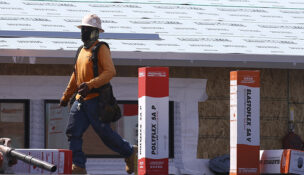Collared urban creatures
Arizona Capitol Reports Staff//August 4, 2006//[read_meter]

All ears – Charlie, No. 851 in an Arizona Game and Fish-funded study, finds shade and privacy in a tree-lined wash that runs through the Tucson neighborhood of Colonia Solana.
Shannon Grubbs leaned out the window of a slow-rolling pickup, hoisting a four-pronged tracking antenna. Next to her, the receiver sounded a repeating ping. The signals came from a transmitter not 30 feet away — on a collar attached to a coyote.
The coyote, a 26-pound male, relaxed under a mesquite tree. For a wild animal, he appeared right at home in Colonia Solana, an upscale Tucson neighborhood.
“He’s 851. Actually, I call him Charlie,” Ms. Grubbs said. “He was the first that we captured, in the beginning of November of last year.”
Charlie, it happens, is part of an ongoing study — along with four other coyotes fitted with radio collars. The Arizona Department of Game and Fish, using a $106,000 grant from the Heritage Fund, wants to get a better idea of what makes urban coyotes tick.
It’s no secret that coyotes have become well adapted to city life, and not only in the Southwest. A coyote was recently captured in New York City’s Central Park.
In Tucson, Game and Fish officials have been fielding calls about coyotes at least since the early 1990s, said Elissa Ostergaard, an urban wildlife specialist for the agency.
City dwellers complain about the noise coyotes make and their taste for small pets. People have reported being bitten as well.
The bites occurred when people — usually children — tried to feed the coyotes, Ms. Ostergaard said.
“It’s been very few over the last five years,” she said. “I think we’ve had three.”
In her study, Ms. Grubbs wants to throw more light on the comings and goings of these urban survivors. She is observing their behavior, eating habits and range.
Judging by Charlie this particular morning, coyotes don’t do much but laze in the shade. But Ms. Grubbs rarely tracks coyotes this time of day. She ventured out in early daylight to give a visitor a glimpse of the coyotes in her study.
Coyotes are most active at night. That’s when Ms. Grubbs heads outs in the officially designated Game and Fish pickup to track Charlie and his mates.
Once on the move, coyotes can travel miles from their own backyard, mostly in search of food, Ms. Grubbs says. And whatever is small and furry usually counts as food.
“They’re very opportunistic,” she said.
She’s observed coyotes eating rabbits, squirrels, pack rats and cats, kittens included.
A night in the life
On a recent outing, Ms. Grubbs began tracking Charlie at 2 a.m. He was with another coyote, No. 770 or “Blue,” so-called because of the color of his radio collar. As always, she followed slowly behind in the pickup. She could see them by streetlamps and her headlights. After each caught a stray kitten, she lost sight of them.
“I found them a few minutes later,” Ms. Grubbs said. “They had just caught this big cat.”
Blue had to wait his turn. Charlie got his share first. Ms. Grubbs figures Charley to be the alpha male.
Compared to Blue, she said, “He is much bigger.”
Having eaten his fill, Charlie ambled back to his usual neighborhood hangout for a five-hour nap. Ms. Grubbs stayed on his trail until mid-morning, logging his activities every half hour.
In tracking coyotes, Ms. Grubbs has become a real night owl. She follows each of them 16 hours a month, splitting the time into consecutive eight-hour stints. That adds up to 80 hours a month for the five coyotes. Last spring, she had help from an undergraduate student.
Ms. Grubbs, 26, is a University of Arizona graduate student herself. Her research will be written up as her Masters thesis, as well as a report for Game and Fish. Paul Krausman, professor of wildlife and fisheries management, oversees her work.
Though Ms. Grubbs usually tracks coyotes alone, she was joined this particular morning by Robert Fink, Game and Fish wildlife program manager in Tucson.
Mr. Fink said the coyote study came about in good part because of complaints in the historic Colonia Solana neighborhood. About a half-dozen adult coyotes make base here. There are pups as well, born into a den between two houses.
Of the coyotes in Colonia Solana, four wear the collars. The fifth collared coyote, a female, stays to the west.
East of downtown Tucson, Colonia Solana pushes up against Reid Park and Randolph Municipal Golf Course. A large wash — Arroyo Chico — cuts through the neighborhood. It’s covered by a thick growth of mesquite trees.
For the urban coyote, Mr. Fink said, Colonia Solana has it all. The vegetation, open spaces and water — including the nearby golf course pond — attract small mammals. Some homeowners occasionally leave out food for critters, though that is now largely illegal.
But what attracts squirrels and bunnies also attracts coyotes.
“Where prey items accumulate, predators will follow,” Mr. Fink said.
The dense vegetation provides shade and privacy as well.
“Most of the time, many people get within 15 feet of a coyote and never even know it,” Mr. Fink says.
Unlike coyotes, Game and Fish officials said they did not seek cover when they proposed the study. They explained it to residents in open meetings. They handed out leaflets. The placed signs along jogging paths.
People were invited to log their own sightings, though few have done so, Ms. Grubbs said.
Not all calls about urban coyotes are complaints, Mr. Fink said. Some people appreciate having wildlife in their midst, coyotes included. Many, however, have no desire for peaceful coexistence. They want the coyotes out.
One caller said pets had a right to run loose about the neighborhood. Then he complained, in Mr. Fink’s words: “Why don’t you take care of your coyotes.”
Ms. Grubbs said she got an earful from a resident outside the Colonia Solana area.
He had spotted her driving around with her tracking antenna. He asked Ms. Grubbs if she had captured the bobcat he called about. She explained that she was studying coyotes.
“So he went off for a long time about how Game and Fish had a lot of enemies now, and the study was just the Game and Fish’s excuse for not doing anything about the coyotes,” she said.
If doing something means removing them, that’s not likely to happen any time soon, Mr. Fink said. As a rule, Game and Fish does not relocate coyotes — unless they pose a danger to people.
“It rarely solves the problem, except in the very short term,” he said. “If we went in and yanked these animals out of there, it would backfill with new animals in no time.”
As long as there’s food and water, they’ll find their way back — or new coyotes will move in to take their place.
The second go-round
As Ms. Grubbs discovered, coyotes can cover a lot of ground in their midnight ramblings.
This observation, however, is not entirely new. Hers, as it happens, is the second Tucson urban-coyote study. Martha Grinder, a doctoral candidate, tracked coyotes in the late 1990s.
In her work, Ms. Grinder learned just how far coyotes will go for food, mates and possibly new territory, said Ms. Ostergaard, the Game and Fish urban wildlife specialist.
“They were covering an area of about 24 square miles,” she said.
Ms. Grinder completed her own doctoral dissertation, “Coyotes in Tucson, Arizona,” shortly before her death at the age of 31. She was killed by a hit-and-run driver July 1999, as she jogged with her baby in a stroller. The infant lived, but was seriously injured. The university awarded Ms. Grinder her doctorate posthumously.
In her study, Ms. Grubbs will be able to generate a more detailed map of the coyotes’ movements. The newest coyote collars use a technology not widely available in the 1990s. Each comes equipped with a global positioning system chip, which uses a satellite to mark exact coordinates. The chip automatically logs the coyote’s position four times a day — midnight, 4 a.m., noon and 8 p.m.
Ms. Grubbs can’t retrieve the GPS data until she gets the collars back. They’re programmed to snap open and fall off next Nov. 30. There is one exception. That’s if a coyote dies.
Of the eight coyotes originally trapped and collared, three have been killed. Two were hit by cars. Witnesses notified public officials, who returned the collars to Ms. Grubbs. She now had an early window to the GPS data. At the Game and Fish office in Tucson, Ms. Grubbs brought up a map of Tucson on a computer. The street grid was overlaid with a splash of dots, all radiating outward from the Colonia Solana neighborhood, or nearby.
The dots represented the four-a-day the GPS readings.
The map grid ended in a white blank several miles to the south. But one set of dots continued into the white space — Davis-Monthan Air Force Base. A female coyote — No. 951 — had wandered into an area off limits to most people.
One night, Ms. Grubbs tracked No. 951 near the air base, though not onto it. As usual, she held the antenna out as she drove, locking in on the collar’s radio waves. She also drew the attention of the base patrol, who called Tucson police.
“The cops came pretty quickly and wanted me to prove I was tracking a coyote instead of an airplane,” Ms. Grubbs said.
At the station, she showed them her data sheet. It was all about coyotes, and police let Ms. Grubbs go.
As for No. 951, the coyote showed a flair for adventure. She liked to nap on cars parked at a nearby Arizona Department of Economic Security complex. DES workers called Game and Fish to complain. No. 951 also enjoyed romps in the park.
“She’d just play on top of picnic tables or jump on the grills,” Ms. Grubbs says with a laugh.
In the end, though, youth and inexperience proved the coyote’s undoing. She was killed in January, just two months after she had been trapped and collared. Like the other coyote killed by a car, she probably was no more than a year old, Ms. Grubbs says.
The third coyote to die, a male, met a different end. He drowned in a pond at Randolph Golf Course. Ms. Grubbs had no idea what had happened to him at first. On one of her outings, she finally picked up a weak mortality signal — set off when an animal hasn’t moved for several hours.
The coyote had somehow fallen into a concrete basin housing a filtration system. The sides were steep and he was unable to get out.
For the remaining five collared coyotes, life goes on. And that means taking advantage of every food source, including prey, wild and domestic. Coyotes don’t distinguish between pets and wild animals, Mr. Fink says. To them, it’s all food. Game and Fish officials have long advised homeowners to keep their pets indoors or in a safe yard.
“We even put out a brochure, ‘Is Your Pet at Risk?’ If it’s not the coyotes, it’ll be the bobcats,” he said. “If the bobcat doesn’t get them, then hawks or owls will actually take some of the real small pets.”
As Ms. Grubbs has observed, pets aren’t always easy prey. A cat can put up quite a fight. And in one-on-one scrapes, when the coyote has no backup, she said, the cat usually has the edge. Sometimes cats even turn the tables.
“I’ve seen this one coyote chased by a cat several times,” she added.
Like a true scientist, when she sees a cat being devoured — she has never seen the actual kill — Ms. Grubbs maintains an emotional neutrality.
<a dog has her day
Sometimes, though, events dish up something of a curve.
That came to light in a follow-up interview. Her answers were punctuated by a dog’s bark. Asked about the dog, she said it was a small cocker spaniel she had picked up about a week earlier while out tracking.
“When I first saw her, she was being chased by coyotes,” Ms. Grubbs says. “They didn’t catch her.”
Ever the scientist, she did not intervene. But then the dog — no longer being chased — started following the truck as Ms. Grubbs slowly cruised the streets of Tucson. Worried the dog might be hit, she picked it up.
The cocker mix had no tags, and nobody responded to the “found-dog” signs she put up around the neighborhood.
Ms. Grubbs named the dog Marta, and she’ll probably keep her. In a rare turnabout, a coyote’s next meal became a household pet.

















